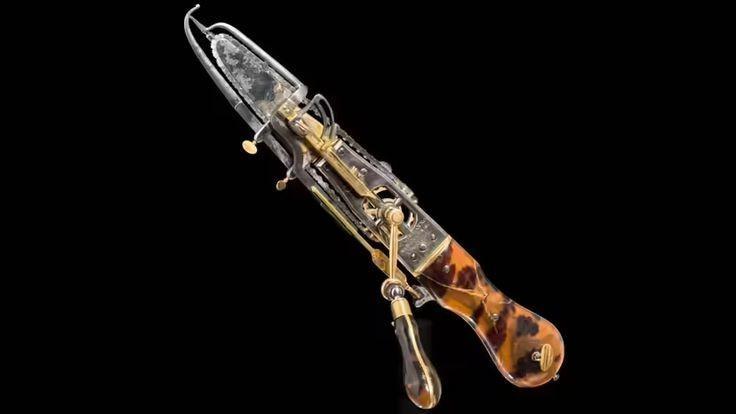Imagine a world where the loud, effective chainsaws that are often used in forestry & construction really originated in surgery! You did read it correctly. It’s possible that the development of chainsaws wasn’t what you first believed.
We’re going to uncover the strange & sometimes violent beginnings of chainsaws in this fascinating historical voyage. We’ll dig into the interesting question: Why were chainsaws invented?
So buckle up to know about “Why were Chainsaws Invented?” Revealing the surprising origins of an instrument that has cut its way into contemporary society.
The Origin of Chainsaw

Image credit – All That’s Interesting
The oldest known prototype of a chainsaw was created by two Scottish surgeons, John Aitken & James Jeffray, in the late 18th century, which is when they are believed to have first appeared. Their invention was intended for a considerably more delicate reason than the tough outdoor activity that chainsaws are now known for: medical treatments.
A hand-cranked serrated chain system that could precisely cut through bone was created by Aitken & Jeffray. The “osteotome,” an early version of the chainsaw, was used for amputations & other medical procedures, speeding up & streamlining operations.
Chainsaws didn’t start to take on a more recognisable shape for cutting wood until the 19th century. Aiming to simplify the tedious process of cutting logs, a German orthopedic physician by the name of Bernhard Heine improved the chainsaw for cutting wood in 1830. In Heine’s invention, a chain with spinning cutting teeth was driven by a hand-cranked device.
Although it would take many decades of mechanical improvements for chainsaws to become extensively utilized instruments in the forestry & construction sectors, this invention lay the framework for the creation of chainsaws as we know them today.
Early Usage of Chainsaw

Image credit – Siete Notas
Here are some early uses of chainsaws to know about “Why were Chainsaws Invented?”:
1. Medical Procedures: Chainsaws were first used in the practice of medicine in the late 18th century. The first surgical prototype was created by Scottish surgeons John Aitken & James Jeffray, who used a hand-cranked serrated chain mechanism to make it easier to operate on bones.
2. Timber chopping: In the 19th century, chainsaws started to take on their contemporary function of chopping wood. In order to chop logs more quickly, German physician Bernhard Heine updated the chainsaw in 1830, turning it into a useful tool for the forestry industry.
3. Logging Efficiency: The efficiency of logging operations significantly increased as chainsaw technology advanced in the late 19th & early 20th centuries. The logging industry’s productivity increased as a result of the ability of loggers to cut down trees more rapidly & with less labor.
4. Military purposes: Chainsaws were used for unusual military purposes during World War II. They were modified for removing obstacles, cutting through thick jungle cover, & even acting as improvised weapons in warfare.
5. Building & Demolition: Chainsaws started being used extensively in building & demolition in the middle of the 20th century. They were used to do activities like chopping timber on construction sites & demolishing structures, which sped up & improved these procedures.
The Brutal Side of Chainsaw

Image credit – All That’s Interesting
Here are some important considerations about the vicious side of chainsaws & know “Why were Chainsaws Invented?”:
1. Execution Techniques: Chainsaws have sometimes been used as a means of execution. This horrible practice has taken place in settings involving organized crime & is meant to cause dread & increase misery. Such executions’ ferocity is quite upsetting.
2. Torture Instruments: In certain horrifying situations, chainsaws have been transformed into torture tools. They are efficient instruments for inflicting dread & suffering on victims because of their ominous look, loud noises, & danger of harm or dismemberment.
3. Horror films: Chainsaws have become recognisable emblems of horror in popular culture, especially in works like “The Texas Chainsaw Massacre.” These films make use of the horrifying potential of chainsaws as weapons, maintaining a gruesome perception of these tools in the public mind.
4. Criminal Use: The dissection of corpses to conceal evidence is one criminal conduct in which chainsaws have been utilized. These incidents show how disturbingly useful chainsaws can be in committing crimes.
5. Psychological Effect: When heard in a threatening setting, the sound of a chainsaw may have a long-lasting psychological effect on those who see or hear about such occurrences, adding to their feeling of dread & anxiety.
Safety Concerns Associated with Chainsaw

Image credit – ACES.edu
Due to their potential for hazard, chainsaw safety considerations are of the utmost importance. Five important safety factors are listed below:
1. Personal Protective Equipment (PPE): When using a chainsaw, the right safety equipment is crucial. This entails donning chainsaw chaps or cut-resistant trousers, a helmet with a face shield or safety goggles, gloves & hearing protection.
2. Training & Certification: Before operating a chainsaw, it is essential to get the necessary training & certification. To avoid mishaps, it is essential to comprehend the machine’s proper starting, operating, & maintenance procedures as well as possible threats.
3. Maintenance & examination: For the chainsaw to operate safely, routine maintenance & careful examination are required. Mistakes during usage may be avoided by making sure the chain is sharp, the chain brake is working properly, & all bolts & nuts are tightened.
4. Safe Cutting methods: Making use of good cutting methods, such as keeping a steady stance, cutting at or below waist level, & avoiding kickback-prone circumstances, helps reduce the chance of injuries.
5. Constant Awareness: When using a chainsaw, users must always be aware of their surroundings. This involves looking for possible dangers such as shaky trees, hanging branches, & ground-level impediments. It’s also essential to keep a safe distance from other people while using a chainsaw.
Modern Day Uses of Chainsaw
Here are some present-day uses of chainsaws:
1. Forestry & logging: Chainsaws are still crucial instruments for felling, bucking, & processing trees in the wood sector.
2. Construction & Demolition: Chainsaws are used to effectively deconstruct buildings during demolition & in construction to cut timber.
3. landscaping: They are used in arboriculture & landscaping for shaping, tree removal, & trimming.
4. Emergency Services: Chainsaws are used by emergency personnel to remove debris after storms & other types of natural catastrophes.
5. Animal Management: Chainsaws aid in managing woods for animal habitat & lowering fire threats via controlled burns in conservation initiatives.
The Future of Chainsaw

Chainsaws’ potential for the future includes greater efficiency, a less environmental footprint, & improved safety. As battery technology develops, more powerful cordless chainsaws with longer runtimes, better mobility, & lower noise levels than conventional gas-powered ones are anticipated to become available.
Additionally, by identifying possible risks & averting accidents, the incorporation of smart technology, such as sensors & automatic safety systems, will make chainsaws safer to operate.
Furthermore, the environmental effect of the use of gas-powered chainsaws will be lessened through the use of sustainable & environmentally friendly materials & enhanced fuel economy.
The chainsaw business is anticipated to adapt & develop in order to satisfy these changing expectations as the globe continues to prioritize environmental practices & safety regulations.
Conclusion
In this article, we’ve let you know about ” Why were Chainsaws Invented?”. The tale of how chainsaws came to be takes us on an amazing trip through evolution & time. Chainsaws have developed from their surprising origins in the realm of surgery to their crucial function in sectors like forestry & construction to become essential instruments in a variety of areas.
This investigation serves as a reminder that the development of technology has often taken unexpected turns & that the modern tools we take for granted may have originated from quite other sources.
The next time you hear the sound of a chainsaw, think back to its interesting & sometimes horrific past, which is a monument to human creativity & adaptability.








